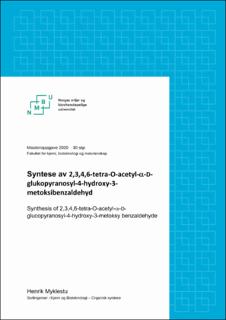| dc.contributor.advisor | Stenstrøm, Yngve | |
| dc.contributor.advisor | Nolsøe, Jens M.J. | |
| dc.contributor.advisor | Antonsen, Simen | |
| dc.contributor.author | Myklestu, Henrik | |
| dc.date.accessioned | 2021-01-27T15:24:26Z | |
| dc.date.available | 2021-01-27T15:24:26Z | |
| dc.date.issued | 2020 | |
| dc.identifier.uri | https://hdl.handle.net/11250/2725048 | |
| dc.description.abstract | Karbohydrater i glykosidbinding med en fenolisk forbindelse kan danne biokonjugater som er en essensiell del av medisinalkjemi. I trevirke finnes karbohydratene xylose, mannose og den fenoliske forbindelsen vanillin som kan bli utnyttet i dannelse av glykosidbinding for potensielle helsefrembringende effekter.
De funksjonelle gruppene i et karbohydrat har ulik reaktivitet og i syntesen blir det vurdert to faktorer om reaktivitet. Reaktiviteten ved det anomere karbonet kan bli utnyttet av en glykosyldonor for å danne glykosidbinding. Den utgående gruppen fra en glykosyldonor kan føre til ulike mellomprodukter, og vil ha betydning for om anomerassistanse inntreffer på det anomere karbonet. Anomerassistansen kan derfor påvirke stereoselektiviteten i produktet. Andre faktorer som påvirker dannelse av glykosidbinding er valg av løsningsmiddel og betydningen av lang-distanse effekt, kompleksitet og stereokonfigurasjonen i beskyttelsesgruppene.
I denne masteroppgaven ble målet om å utvikle en syntesestrategi av 2,3,4,6-tetra-O-acetyl--D-glukopyranosyl-4-hydroxy-3-metoksibenzaldehyd (5) oppnådd med et totalt utbytte på 60 % over tre syntesetrinn. Syntesen ble først utført ved å benytte acetyl beskyttelsesgrupper for å unngå uønskede reaksjoner og kontrollere stereoselektiviteten. Deretter ble to ulike glykosylhalider utprøvd som glykosyldonor og gir et utgangspunkt for å danne glykosidbinding med vanillin under bifasiske betingelser. Først ble 8 forsøkt dannet fra 6, derimot ble syntesetrinnet vellykket i dannelse av et mer stabilt 7.
Glykosylbromidet ble utprøvd med to ulike PTC-er. Den første PTC-en var forsøkt med TBAHS, men gav ingen dannelse av 5. Videre ble PTC-en TBAB utprøvd, denne gangen med to ulike baser. Ved bruk av basen NaOH gav det ingen dannelse av 5, derimot ved bruk av basen K2CO3 ble det dannet glykosidbinding i 5.
Syntesestrategien utviklet i denne masteroppgaven tilsier at det er god mulighet for å oppnå glykosidbinding i hver av utgangsstoffene xylose og mannose i reaksjon med vanillin. Disse biokonjugatene kan dermed være verdifulle prebiotiske forbindelser i fremtiden. | en_US |
| dc.description.abstract | The glycoside bond between carbohydrates and phenolic compound can form bioconjugates which are an essential part of medicinal chemistry. Wood exists of the carbohydrates xylose, mannose and the phenolic compound vanillin, which can be used to form glycoside bonds for potential health promoting effects.
The functional groups in a carbohydrate have different reactivity. In the synthesis, two factors of the reactivity were considered. The reactivity at the anomeric carbon can be utilized by a glycosyl donor to easier form a glycoside bond. The leaving group at the glycosyl donor may lead to various intermediates and will impact whether anomer assistance occurs on the anomeric arbon. That makes anomeric assistance may affect the stereoselectivity to the product. Other factors that influence the forming of glycoside bond are the choice of solvent in the synthesis and the importance of long distance effect, the complexity and stereoconfiguration of the protecting groups.
In this master's thesis, the aim of developing a strategy for synthesis of 2,3,4,6-tetra-Oacetyl--D-glucopyranosyl-4-hydroxy-3-methoxybenzaldehyde (5) was achieved with a total yield of 60% over three synthesis steps. The synthesis was first performed by using acetyl protecting groups to avoid unwanted reactions and to control the stereoselectivity. Then, two different glycosyl halides were tested as a glycosyl donor to prepare the forming of glycoside bond with vanillin under biphasic conditions. First, 8 were attempted to form from 6, however, the step was successfully by forming a more stabilized 7.
The glycosyl bromide was tested with two different PTCs. The first PTC attempt was using TBAHS, unfortunately this step gave no formation of 5. Furthermore, the PTC of TBAB was attempted, this time with two different bases. Using NaOH gave no formation of 5, whereas using K2CO3 did successfully give a glycoside bond to form 5.
The strategy of the synthesis developed in this master's thesis indicates that there is a good possibility of achieving glycoside bond in each of xylose and mannose in reaction with vanillin. Thus, the bioconjugates can be valuable prebiotic compounds in the future. | en_US |
| dc.language.iso | nob | en_US |
| dc.publisher | Norwegian University of Life Sciences, Ås | en_US |
| dc.rights | Attribution-NonCommercial-NoDerivatives 4.0 Internasjonal | * |
| dc.rights.uri | http://creativecommons.org/licenses/by-nc-nd/4.0/deed.no | * |
| dc.title | Syntese av 2,3,4,6-tetra-O-acetyl--D-glukopyranosyl-4-hydroxy-3-metoksibenzaldehyd | en_US |
| dc.title.alternative | Synthesis of 2,3,4,6-tetra-O-acetyl--Dglucopyranosyl-4-hydroxy-3-metoksy benzaldehyde | en_US |
| dc.type | Master thesis | en_US |
| dc.description.localcode | M-KB | en_US |

